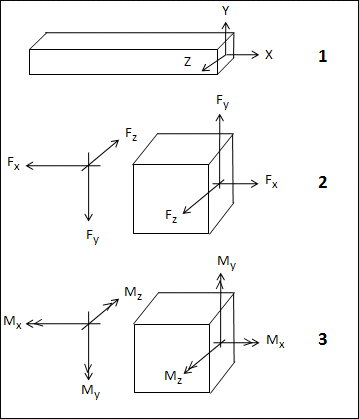Strategy: Interpreting Beam Resultant Forces and Moments
You can interpret the result of structure reports when you understand the sign conventions used for beam resultant forces.
The following figures illustrate the sign conventions Creo Simulate uses for resultant forces and moments in beams. The X-axis of the beam is defined along the beam length.
1. Beam's positive X direction
2. Resultant forces
3. Resultant moments
In the positive direction of the beam element, positive Fx acts in the positive normal X-direction. However, in the negative direction of the beam element, positive Fx acts in the negative normal X-direction. The resultant moments follow the same sign convention.
Applying this resultant force and moment convention to a typical example, note how the results of a beam model solved in Structure relate to a free body diagram.
In the cut section, the resultant forces Fy and moment couple Mz act to maintain equilibrium. In beam a, Fy is negative while, in beam b, Fy is positive. Mz is negative in both the beams. Structure always reports values for the resultant forces and moments for the positive direction of the free body diagram.
The X-axis for beams is along the length of the beam, with the positive X-direction determined when you select the
beam references. To find the positive beam direction, look at the orientation of the beam icon axes. The beam icon displays the Y-and Z-axes for the
BSCS. You can determine the positive X-direction using the right-hand rule.
To understand how
Creo Simulate evaluates the sign conventions used for beam resultant forces and moments, see the example -
Resultant Force for a Simple Spring or Beam Model.
Therefore, Creo Simulate reports resultant values based on the positive beam direction. You must review the orientation of the BSCS before you run an analysis to enable you to interpret the results accurately. The signs of the resultant forces and moments change when you reverse the orientation.


